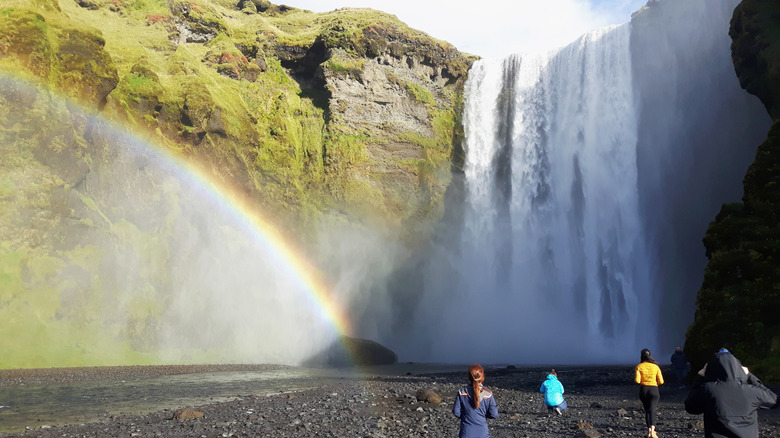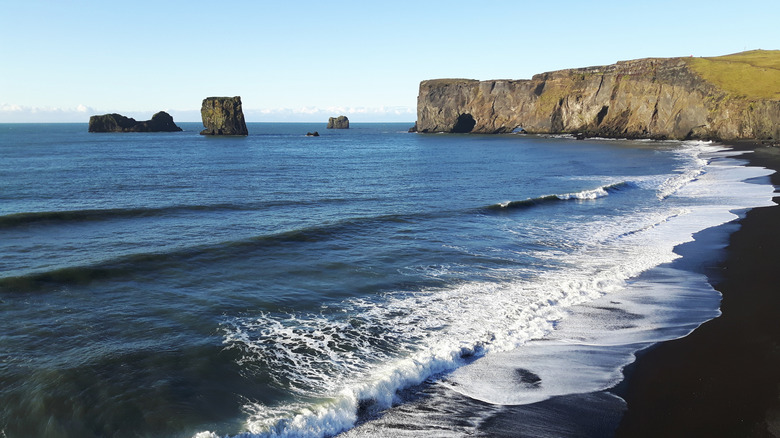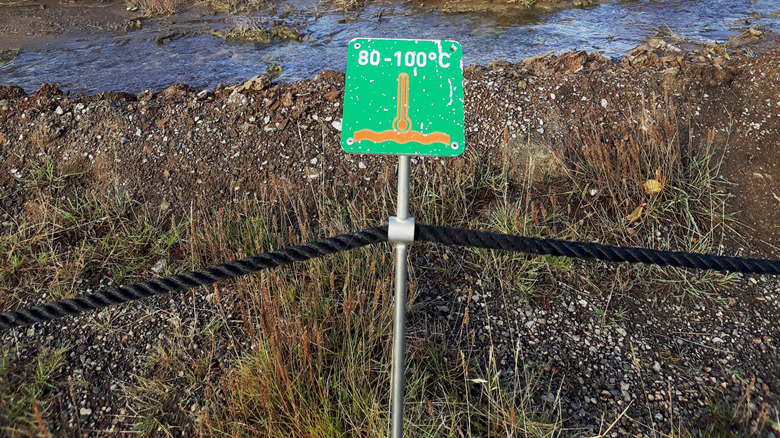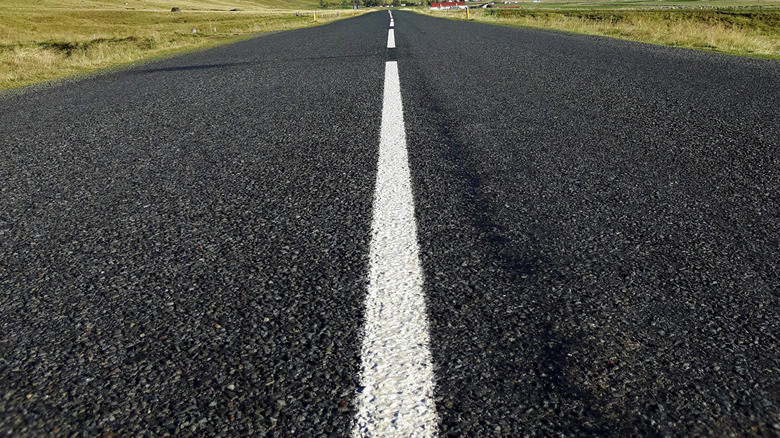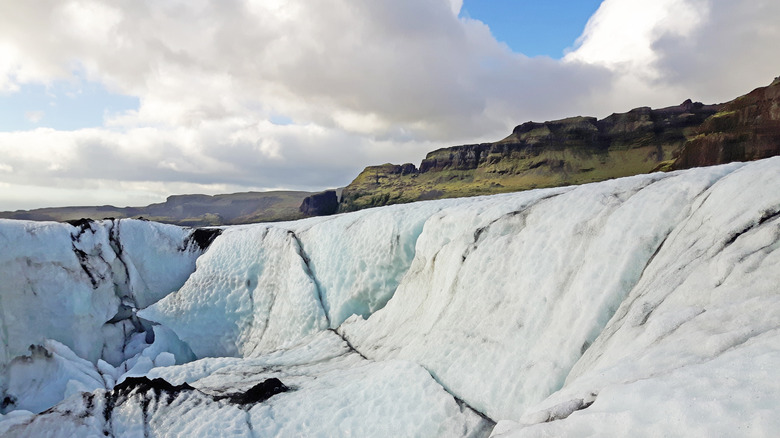Rick Steves Warns Tourists To Avoid These Common Dangers While Exploring Iceland
Iceland, or the Land of Fire and Ice as it's commonly known, is one of the most beautiful and mysterious travel destinations in the world. Volcanoes, geysers, glaciers, and black sand beaches are just some of the many natural wonders travelers will get to experience while visiting this incredible Nordic country. While knowing helpful travel hacks when visiting Iceland can help you prepare for your trip, travel expert Rick Steves warns tourists to avoid some very common dangers that lurk there.
Although stunning, Iceland can be filled with hazards that can turn your trip of a lifetime into a life-ending trip. Sadly, every year an estimated 25 tourists perish while visiting Iceland. Steves urges visitors to be cautious when visiting Iceland on his blog, stating that "Several times a year, Icelanders are captivated by a full-scale land and helicopter search for travelers sucked out to sea by a wave, separated from their snowmobile tour group, or lost in the wilderness."
Since I was a teenager, Iceland was high on my bucket list of countries I wanted to visit. I always had an admiration for Icelandic culture, and knew I would fall in love with it the moment I arrived. From the first glance of massive mountains that were sprawled in front of me while driving along Ring Road, to the vast green pastures dotted with Icelandic horses, it was easy to see why people need to visit Iceland. It was also very easy to see just how unforgiving dangers such as road conditions, distracted drivers, and even roaming sheep can be to unprepared, or careless tourists. Here are a few common dangers in Iceland, and how to prepare for them.
Sneaker Waves
Iceland's Southern coast is famous for its out-of-this world black sand beaches. In the tiny seafront village of Vík í Mýrdal (commonly referred to as Vík), you'll easily see why places such as Reynisfjara beach and the Dyrhólaey Arch are some of the top places to see along Ring Road. Reynisfjara beach was once voted one of the top 10 most beautiful non-tropical beaches in the world, so of course, you're guaranteed to see plenty of tourists walking its black onyx shores.
The sandy beaches with waves crashing to shore may be tempting to walk along, or to dip your toes into, but Steves mentions the dangers of sneaker waves, which can unexpectedly suck tourists into the icy cold waters and pose a drowning hazard. This type of wave comes crashing to shore larger and more powerful than the last, catching unprepared tourists off guard more times than not. When I was traveling in Iceland, I was told that not too long before my visit, a German tourist walking along the water was sucked in and was regrettably not recovered.
Scalding thermal water
What may look like an innocent puddle of water, might actually be a scalding hot geothermal site. The geysers of the geothermal Haukadalur area in Iceland are situated along the famous Golden Circle route, which sees approximately two million tourists each year that patiently wait for the 98-foot-high burst every five to ten minutes. Visitors will see signs that are situated along the site letting tourists know that the temperature of the pools of water are near boiling at almost 212 degrees Fahrenheit.
Don't get burned at these magnificent sites and stay back. Iceland is very much like an unsupervised tourist playground, and with a lack of authority around to monitor visitors, some ultimately face horrific consequences. Steves mentions in his post that roughly "every year or two, a tourist falls into the scalding hot waters and gets severely burnt." The most visited geyser is the active Strokkur geyser, which has boiling water temperatures, so keep your hands out of the water.
Road conditions
Icelandic people will tell you with a smile, "if you don't like the weather ... just wait five minutes." As quickly as the weather can change, so can road conditions, and those that are only used to driving in dry weather may be in for a wake-up call. During my time in Iceland, what started as a bright and sunny day quickly turned into one of the bridges that I had to drive across being damaged by a storm.
If the roads get blanketed with a fresh dusting of snow and you aren't used to it, it's important to adjust your speed and proceed with caution, as many accidents are known to occur with tourists that don't adjust their driving to road conditions. In the case of an emergency on the road, having an emergency kit in your car's trunk can certainly help. Calling 112 in Iceland will get you emergency services in English, and alternatively visiting safetravel.is will provide updates on everything from road conditions to safety tips about road-tripping in Iceland.
Hiking hazards
Adventurous activities are at your fingertips while traveling in Iceland. Hiking a glacier is certainly one of them, and many tourists each year strap on their crampons and traverse the unknown. During my travels in Iceland, I had the opportunity to hike and do an ice-wall climb on the majestic Sólheimajökull Glacier, and while stunning, it was easy to see just how unforgiving some areas could potentially be. Booking a tour with an experienced and professional guide is highly recommend due to the unforeseen dangers that may lurk on the glacier, such as deep crevices that hikers have fallen or slipped into while attempting to hike unassisted.
Getting outdoors in Iceland is one of the best ways to experience this incredible country, however, it can also be extremely dangerous. In the winter months, avalanches can occur unexpectedly and on Steves' blog, he mentions how "Icelanders have taken this danger more seriously since 1995, when two avalanches in the Westfjords killed 34 people." Steves also goes on to mention the potential risk of trail hazards by saying, "There are very few ropes, guardrails, or warning signs in Iceland — but if you see any, take them seriously. Step carefully, and watch out for loose stones, crevices, and sharp lava rocks."
At the popular Jökulsárlón Glacier Lagoon, I've seen tourists standing on the floating ice, and there was an incident when a piece of the glacier collapsed and caused rushing water and waves, resulting in visitors making a run for shore. It's best to remember just how powerful Mother Nature can be, and while an adventurous holiday is something to remember, making it home safe and sound is just as important.
